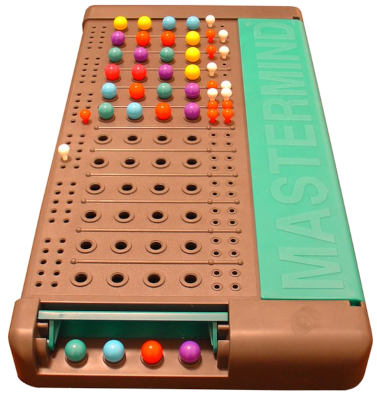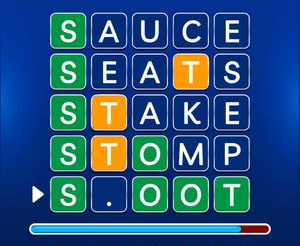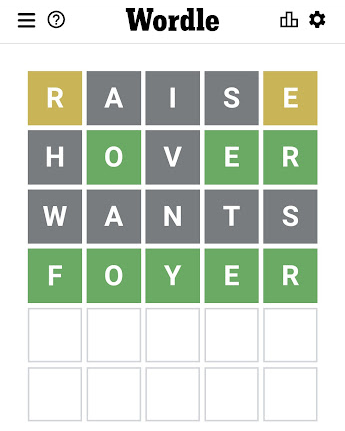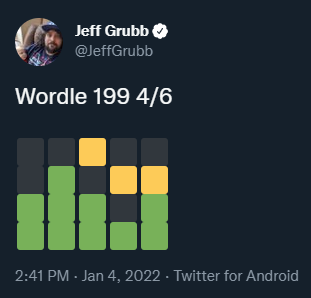
The activities games have us perform are powerful determinants of their identities, but the treatment and presentation of those activities counts for a lot as well. Josh Wardle's Wordle is a hodgepodge of features from other code-cracking puzzle games, including Hangman, Mastermind, Lingo, and Jotto. Yet, its unique interpretation and implementation of its peers' ideas mean it stands out from the pack and earned it upwards of 2 million daily players. It's worth asking, how did Wordle spin standard word puzzle concepts into gold?
Mastermind
Our search for Wordle's roots starts in 1970, when Mordecai Meirowitz's board game, Mastermind, met its public for the first time. In Mastermind, one player takes the intriguing title of "codemaker", and the other becomes the Turingesque "codebreaker". At the start of a round, the maker enters a hidden code into the four slots in front of them. Each character in that code must be one of six coloured pegs. The breaker then gets a limited number of turns to guess that string. The maker responds to each of the breaker's guesses by telling them: A. Which of the colours they guessed is part of the pattern, and B. Where they have guessed both colour and slot correctly. If the breaker submits a combination identical to the maker's before all their turns elapse, they win. Otherwise, the round goes to the maker. Mastermind does not represent the first incarnation of this enigmatic competition. A similar pen and paper game called Bulls and Cows long predates it, but that's a little more complicated to explain.

If you play Mastermind long enough, it'll get predictable, and you'll inevitably be hungry for a greater and more varied challenge. When describing Hexic HD, I mentioned that that game boosted the difficulty of the match-three puzzler by increasing the number of colours in play and bumping up the quantity of elements the player acts on at once. We can apply the same modifications to increase Mastermind's difficulty. If you made the codes longer and gave the maker more potential items to place in each space, you'd end up with a tougher game that generates more diverse patterns. You could also make the puzzle more cryptic by reducing the number of guesses the breaker gets.
Hangman
Hangman chisels away at Mastermind's marble to implement all those changes. Or, at least, it can if you play it right. In Hangman, players do not set and guess colours; they toy with letters instead. To many players, this exchange of vivid hues for consonants and vowels would seem to place these games in two different leagues, and in some sense, they'd be right. However, we must remember that the presentation of a mechanic is not the mechanic itself. The letters in Hangman serve a function analogous to the colours in Mastermind: they are unique elements that the maker places into the slots of the code and that the breaker must discover. You could also use numbers or any other symbols for your code-cracking game. In fact, Bulls and Cows does use numbers.
Where Mastermind only supports four-character codes, Hangman players are typically free to set any code length they want. While a round of Mastermind lasts eight to twelve turns, Hangman's come in at five to six. And with the alphabet as the basis for Hangman's cryptography, it has twenty-two more symbols to construct secret phrases with than Mastermind does. Here is the variation and steepening of the difficulty we've been looking for. So, where does using letters instead of numbers make a difference?
Well, when the designer is working with only six colours, they can pick shades that their audience can uniquely identify. Yet, players would have trouble telling apart colours if handed twenty-six of them. They'd be staring at the pegs like a jeweller examining a diamond. And no colourblind person is going to get within sniffing distance of your game if its pieces blend that closely together. However, most people can distinguish letters without a second thought, even if they don't have the same aesthetic pop as colours. So, the trade of colours for letters expands the possible variables in the codes.
Of course, where Mastermind allows the maker to use any character in any slot, the "defender" in Hangman must exercise more discipline. Their code must constitute an established word. But overall, the maker in Hangman has vastly more options than their counterpart in Mastermind. There are 1,296 different sequences you can play in Meirowitz's creation, but the Oxford English Dictionary lists approximately 600,000 words.
Many games develop an internal language. For example, in Carrion, an empty hole means the chance to save and heal. In Solomon's Key, a "Devil Emblem" indicates a space in which you cannot place a block. Hangman could also speak through proprietary icons, but that would make it considerably harder to learn. Memorising twenty-six new runes isn't easy. However, letters are twenty-six shapes we all have memorised before entering the arena. Hangman provides a lesson in the advantages of basing a game on knowledge the player has from outside the hobby rather than trying to teach them something original.
Despite the volume of characters in Hangman, the breaker receives somewhat of a reprieve in that they don't have to guess the correct position of each element, just what those elements are. That's not the case in Mastermind. This demand for less specific inputs could reduce the intentionality of the attacking player's moves, diluting Hangman's depth. However, the benefits of applying real-world language can step in here. The application of English means that Hangman can test the lexicographical knowledge of both the maker and breaker instead of just being an abstract guessing game.
In Hangman, a skilled maker can find words that deviate from the usual linguistic rules or otherwise throw the breaker a word that doesn't follow the patterns they've seen before. A smart breaker can think outside the box and not get too locked into certain types of guesses. While there are more prickly languages than English, it is one of the more challenging word sets to play Hangman with. It has no shortage of elements loaned from other languages, and few rules in its construction are inviolable.
While the codes of Mastermind are generally semantically neutral, all words are charged with meaning. So, Hangman's passphrases can carry connotations that Mastermind's can't. Sequences like "cassette" or "actor" possess personalities that solutions like "Blue-Red-Purple-Red" don't. But plenty of bored schoolkids playing endless matches of Hangman have found that success in the game can be somewhat arbitrary. Firstly, while Mastermind controls the difficulty in each phase by setting the code to a length of four, Hangman players rarely institute word length limits. That lack of limits means the degree of challenge between rounds can be inconsistent.
It may seem like longer words have more letters you can guess in them, counterbalancing this issue, but that's not necessarily true. There are well-known words with eight or more letters in which none of the characters repeat, like "microwave" or "friendly". These are just objectively superior strings for the maker to play. And it's when you encounter them that the second problem with Hangman becomes apparent: That even with some very cunning strategy, it's not that unlikely that the breaker will get drawn and quartered for guessing the wrong letters. While you can sometimes logically infer details about a word in Hangman as you unlock characters, other times, there are too many possible options left open, even as you keep submitting guesses. If the maker stumbles on the right sequence of letters, you end up randomly inputting answers, and the game begins to lack a deductive component. Maybe a gambling game is what you're after, but I think a lot of people invested in word games are after a test of skill.
You can write in-house rules to solve the problem of word limits, but play becomes far more contrived if you do that for the problem of randomness. The players can agree to a maximum length for a word, but the most obvious way to stop the breaker from stumbling about in the dark would be to limit the number of different characters the maker can use in a sequence. Once you do that, it takes them longer to guess a valid word and start the game. They can also feel as though they are arbitrarily restricted from making the optimal moves. You could solve the problem with a mechanic like a hint system, but at a certain point, you're robbing Hangman of its simplicity. So, where can we turn if we want a minimalist word guessing game with controlled word length and more logical decision-making? We can turn to Lingo.
Lingo
Lingo is a TV game show that first aired in the States in 1987. The goal of Lingo is the same as the breaker's goal in Hangman: guess the hidden word. However, like the combinations in Mastermind, the mystery words of Lingo have a fixed length. Just as Mastermind gives breakers feedback on whether a colour they've guessed is in the code and whether they've placed it correctly, Lingo does the same for letters, lending it the detective work that Hangman lacks. Even better, Lingo's UI is demonstrably more efficient than Mastermind's. See, in Mastermind, the breaker has one area of the board in which they submit their guesses, and next to it, a whole other area in which the maker places feedback pegs. The breaker has to check back and forth between the feedback zone and the guess zone, comparing the two, to ascertain how close an attempt was to the real solution.
In Lingo, when a player submits a guess, the characters in that guess are backed by one of three colours, indicating something about their relationship to the answer. The colour scheme works as follows:
- Default Colour: The character is not included in the answer.
- Yellow: The character is included in the answer but is in the wrong position.
- Green: The character is included in the answer and is in the correct position.
Now, the player does not have to carefully work out which feedback peg lines up with which guess peg. All the information they need is in one area, and the markers of their success clearly align with the elements of their code. Here's a sample Lingo board:

If you've played Wordle, you'll notice that its rules and wrapping are almost exactly Lingo's. Lingo is just played against a clock and may have slightly different word limits than Wordle. But there's one fundamental issue which means Lingo can never plug the holes in Mastermind and Hangman we want it to. Lingo is a game show and is played by other people instead of us. Plenty of game shows we can play along with at home. Quizzes and visual puzzle games such as Catchphrase make for convenient armchair participation. However, that interactivity is only possible because there's no causal connection between the challenges in those programmes. You may respond differently to a question or puzzle than the player on screen, but if you do, both you and the player receive the same puzzle or question next time.
Lingo's puzzles don't have you confronting tasks in which you make one input, immediately get a "success" or "fail" output, and move on. Its grids make you use multiple input strings to explore a possibility space, searching for the "success" state. In any stage of a Lingo session, the chances are that you and the contestant will guess a different word, and so, the contestant will receive different feedback than you would in their place. As that feedback affects your concurrent inputs and is how you feel your way towards a solution, if the game isn't replying to you, you can't play it. This is how most games work. You can't participate in Lingo using a recording of it any more than you can play along with a recording of Inscryption or StarTropics because those games also exist as a conversation between you and a system. So, Wordle is not just Lingo on a different platform; it's the door through which we access Lingo's otherwise unplayable puzzles.
Wordle

Wordle has an almost scientific control of its difficulty, a deductive component, simple rules, and it puts us in the driver's seat. Yet, there are thousands of word games you could install on your phone matching that description. Wordle got catapulted to stardom when most of its competitors languished in obscurity. And it earned its reputation organically instead of through an immense marketing campaign, a recognisable brand, or any particular celebrity endorsement. That requires an explanation.
I think Wordle's popularity comes down to two factors: how it fits into your free time and how it enmeshes with social media. On the first point: a new Wordle is published at midnight every day, and at that time, the previous puzzle is removed, never to be solved again. Unlike in Hangman, Lingo, or Mastermind, the player has time to think about the solution to a Wordle because they're not playing it in a relatively short session with a tightly defined beginning and end. Its puzzles can easily bang around in your head over the course of the day, taking root in your psyche. Connections permitting, you can then load up the game and make another guess whenever and wherever you want. This accessibility is possible because Wordle is not played on a board or in a video game with a resource-intensive engine but on a low-overhead web page.
Notice that Wordles are not events scheduled for a specific time like episodes of 1 vs. 100 or Forza Horizon 4's Forzathon Live showcases. In the latter titles, the player may miss a crucial event because their lifestyle does not fit around the developer's calendar. Through such stringent timetabling, these games or features can limit their audiences. In comparison, Wordle is open to anyone, no matter how they've planned their day, as long as they can connect to the internet within each 24 hour period. On the opposite end, the limited timeframe in which you can access each puzzle keeps users coming back on a daily basis.
Daily tasks and rewards are a staple of live service products because developers want to make play a habit. However, in most titles of this genre, you can participate to your heart's content, and if there's a lock on reentry, it's generally a timer you can pay to skip. Wordle is effectively inactive between when you complete the puzzle and midnight, and you can't change that with any amount of money.
Most media platforms are built on unlimited access to their content. Sites and apps boast about the endless games, articles, or videos that litter them. But when these services are all-you-can-eat, you can lose your appetite. Wordle embraces that old entertainment adage: "always leave them wanting more". If you're enthusiastic about code-breaking, you probably won't get your fill of Wordle from one puzzle, enticing you to come back the following day.
As invested players are returning to the experience seven times a week, that's also seven chances for them to share their result to social media. That avalanche of Wordle posts has no doubt been instrumental in popularising the game. But just about every mobile game has a button that lets you copy your results to an external profile. Why is Wordle more persuasive in getting players to click theirs? And why has the title received so much social buzz? I think we often make the mistake of designating single-player games solitary experiences and multiplayer games social experiences.
Wordle is a classic example of a single-player game as a social phenomenon. There are many titles in which we cannot directly compare our experiences to those of other players. For example, suppose you and a friend each play a run of Enter the Gungeon. In that case, you're going to end up with different maps, different weapons, and other variables which make your sessions unique. If you each play one matchmade game of Killer Instinct, you're going to be up against different opponents, and the matches will quite probably involve different characters. You could take stats from different sessions of these games and compare them against each other. For example, seeing how much health you and your friend were left with at the end of your Killer Instinct bouts or how much gold you each collected in Enter the Gungeon. Yet, because the matches and the dungeons vary, you could never claim that you did better than your opponent at the specific task they did.
In Wordle, all players get the same puzzle with the same number of guesses per day, making success at each grid highly comparable. You know not just whether your friends that day got to a word in more or fewer guesses than you did; you know that they got to "ULTRA" or "TABBY" faster or slower than you. When we post the results of a competition to a video game leaderboard, they're usually quite abstract; think a time or a score. Wordle's results are able to tell more of a story about the game that was played. We don't just learn how many attempts other players took to find the code; we see a version of the game grid without the letters filled in.

A little like in a televised sport, in Wordle results, we can see strong starts, mid-game fumbles, miraculous recoveries, and much more. When we view the history of other peoples' matches, we can compare them to our own, feeling smart where we beat out opponents and cringing at our comparative blunders. Most puzzles games cannot surface this degree of detail about others' matches without spoiling their solutions. Wordle is able to do it because its interface delivers feedback that is bound to each input we give it, and yet, abstracted from those inputs. And that abstraction only tells us about the relative validity of the input, not the underlying input itself.
It's also relevant that you can represent a whole game of Wordle in just thirty characters. This brevity of the records allows both for them to fit into a single tweet and for players to scan those tweets quickly. The imprints of Wordle games are detailed and yet brief because the data we give the game is simple. This does not mean that playing the game does not make us sweat because we might flip through a small dictionary of guesses in our head before deciding what characters to jot down on the screen. However, only five characters result from those considerations. If you were to capture and report all of someone's inputs or successes and losses in most other puzzles such as a crossword or Baba is You, the post-mortem would be considerably longer.
That's all I have for you today. We've looked at how we can compare code-cracking games in terms of the nature of the elements in their codes, their control over code length, their feedback mechanisms, and much more. While the differences between titles in this crowded genre are subtle, the sheer quantity of entries in the field means that it's always going to be the little touches that put one game over the top. With its encouraging timetabling and share-friendly results, Wordle is currently that game. Thanks for reading.
Notes
- Image of Mastermind is derivative of original content by ZeroOne. Licensed under Creative Commons Attribution 2.0 Generic.
Log in to comment